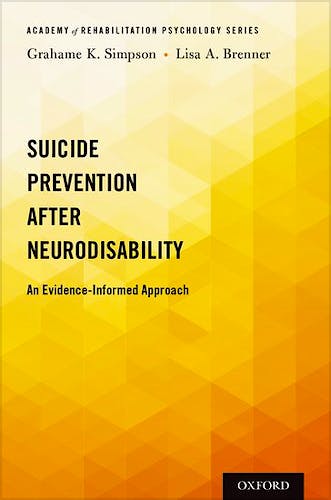

There are no products in the cart.



Suicide Prevention after Neurodisability. An Evidence-Informed Approach
Simpson, G. — Brenner, L.
1ª Edition March 2019
English
Soft Cover
288 pags
400 gr
16 x 24 x 2 cm
ISBN 9780199928415
Publisher OXFORD UNIVERSITY PRESS
Printed Book
-5%
49,65 €47,17 €VAT included
47,74 €45,36 €VAT not included
Receive it within
2 - 3 weeks
Acknowledgements
Dedication
Preface
PART 1
UNDERSTANDING SUICIDE AFTER NEURODISABILITY
Chapter 1 Introduction
Chapter 2 Understanding neurodisability
Chapter 3 Understanding Suicide
Chapter 4 Theories of suicide
Chapter 5 Neuroanatomy, neurobiology and neuropsychology of suicide
Chapter 6 Epidemiology, risk and protective factors for suicide after neurodisability
PART 2
SUICIDE PREVENTION AFTER NEURODISABILITY
Chapter 7 Screening for suicide risk
Chapter 8 Suicide risk assessment
Chapter 9 Evidence-based interventions
Chapter 10 Clinical practice approaches
Chapter 11 Cross-cultural practice in suicide prevention
Chapter 12 Public health and organizational approaches
Chapter 13 Legal and ethical issues
Chapter 14 Conclusions
Appendix 1
Reference List
Suicide risk after disabling neurological conditions is up to five times higher than for the general population; however, knowledge about the extent of the problem, associated risk factors, and effective evidence-informed suicide prevention approaches are limited and fragmented. Suicide Prevention after Neurodisability focuses on the challenges faced by eight different types of neurodisability, namely stroke, spinal cord injury, traumatic brain injury, amyotrophic lateral sclerosis, epilepsy, Huntington's disease, multiple sclerosis, and Parkinson's disease. It pulls together the current knowledge about this risk, detailing a complex interplay between neuropathological, psychiatric, psychological, and psychosocial factors that in part account for this increased presence of suicidal thoughts and behaviors.
Despite the challenges, suicide is often preventable. The best available evidence-informed approaches to suicide prevention in neurodisability are outlined, including clinical approaches to screening, suicide risk assessment, psychotherapeutic interventions, and psychosocial management. The reader-friendly approach will help make suicide prevention after neurodisability everyone's business.
- Examines how to assess and prevent suicide in progressive neurological disorders
- Investigates suicide and prevention among veterans with traumatic brain injury
- Explores suicide after eight neurological disorders: stroke, spinal cord injury, traumatic brain injury, amyotrophic lateral sclerosis, epilepsy, Huntington's disease, multiple sclerosis, and Parkinson's disease
Grahame K. Simpson, PhD is an Associate Professor and has worked as a clinician and researcher for the past 30 years in the field of brain injury rehabilitation at Liverpool Hospital in Sydney, Australia. Over the last 2 decades, he has undertaken and published pioneering research into the epidemiology, psychological mechanisms and risk factors for elevated suicidal behaviors after traumatic brain injury, as well as trialing new psychological treatments for suicide prevention. Lisa A. Brenner, PhD is a Board Certified Rehabilitation Psychologist, a Professor of Psychiatry, Neurology, and Physical Medicine and Rehabilitation (PM&R) at the University of Colorado, Anschutz School of Medicine, and the Director of the Department of Veterans Affairs Rocky Mountain Mental Illness Research, Education, and Clinical Center. She is also the Research Director for the Department of PM&R, and the Marcus Institute for Brain Health.
© 2025 Axón Librería S.L.
2.149.0